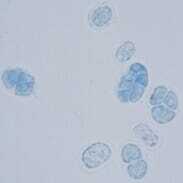
Prototheca zopfii
Credit: Faculty of Health and Medical Sciences – University of Copenhagen - Denmark
Prototheca mastitis has recently become an emerging disease. Once thought to be a problem only for dairies in tropical regions, the incidence of this invisible pathogen is now increasing steadily internationally.
For example, a 2019 study published in the Journal of Dairy Science indicated Prototheca zopfii (genotype 2) is the third most common mastitis pathogen in southeast Poland.
A study (P. Moroni, Diseases of the Teats and Udder, Rebhun's Diseases of Dairy Cattle, 2018.) of a large confinement operation in Germany involving 248 Prototheca-infected cows showed:
- 74% of the cows had clinical signs of mastitis
- 80 cows were identified as infected from a whole-herd survey but without a history of clinical mastitis
- 27% of the cows were infected in more than one quarter
Overview of Prototheca Mastitis
Prototheca are unicellular algae that can cause udder infections. The colorless pathogen is found in cow manure, soil and water, bedding, feed, barns and barnyards. Infected cows can also serve as reservoirs for the infection for other cows and infected cows usually advance to chronic cases. Thus, it is considered both an environmental and contagious pathogen. As algae, Prototheca have different cell walls than Gram-negative or Gram-positive bacteria, and therefore don’t respond to antibiotic treatment.
Symptoms
Prototheca can exist in a herd as a subclinical infection with no symptoms or slightly abnormal milk or as a clinical infection showing watery milk.
Chronic infections will decrease milk production as the organism continues to damage the udder by infiltrating the macrophages, plasma cells and lymphocytes, and it will increase the cow’s somatic cell count.
Risk Factors
Transmission occurs through the teat end. As noted earlier, Prototheca spp. are commonly found in the dairy environment and cow-to-cow transmission is an ongoing concern. Risk factors to consider:
- Naturally wet areas of the farm
- Periods of warm temperatures and heavy rainfall
- Recycled sand bedding washed with effluent from a lagoon
- Poor hygiene practices
- Contaminated intramammary infusion equipment
- Cow-to-cow transmission in the milking parlor
- Cow-to-cow transmission in the hospital pen
Diagnosis
Because Prototheca grow so slowly on traditional culture plates which are optimized for bacterial growth, culture can provide false negative results. Due to the economic impact a positive Prototheca or false negative result could have on a dairy farm, diagnostic laboratories now offer more advanced diagnostic tools, like PCR, that can provide clear results to veterinarians and producers. This allows producers to more rapidly segregate infected cows from the herd and cull animals as needed.
For more information on mastitis diagnosis, click here
Treatment
There are no effective or approved treatments available for Prototheca mastitis. Prototheca is unresponsive to antibiotic treatment.
Additional Resources:
Prototheca: A Nasty Little Bug for Cows
Mastitis Control Program for Prototheca Mastitis in Dairy Cows
Prototheca spp.: A Practical Summary for Controlling Mastitis
